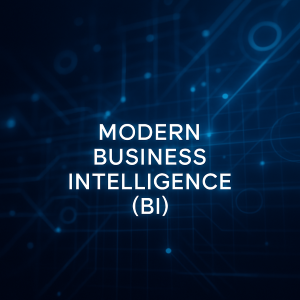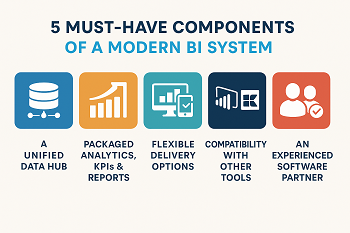What Today’s Modern BI Systems Do That Legacy Reporting Tools Can’t
 Analytics and business intelligence (BI) are no longer optional—they’re essential. In today’s fast-moving business landscape, leaders need immediate, trustworthy insights to outpace competitors, spot trends before they escalate into problems, and seize opportunities as they arise.
Analytics and business intelligence (BI) are no longer optional—they’re essential. In today’s fast-moving business landscape, leaders need immediate, trustworthy insights to outpace competitors, spot trends before they escalate into problems, and seize opportunities as they arise.
But to do that effectively, they need more than just spreadsheets and static dashboards. They need visibility across multiple internal systems—like ERP, CRM, and financial platforms—and even external sources shared with suppliers, partners, and customers.
That’s why modern BI systems are quickly becoming the go-to solution for data-driven enterprises. They integrate, align, and activate data across the business to drive better, faster decisions unlike legacy reporting tools that can’t.
BI Has Come a Long Way
The concept of “business intelligence” has been around for decades. Early BI systems—mostly OLAP tools—relied heavily on pre-processed data from warehouses. They served a purpose but lacked flexibility and real-time relevance.
Today, BI is smarter, faster, more affordable, and infinitely more powerful. Modern platforms pull data from a wide array of sources: ERPs, relational databases, Excel files, cloud apps, third-party providers, and beyond. And with intuitive interfaces and built-in AI capabilities, BI isn’t just for analysts anymore, it’s for every decision-maker in the organization.
But let’s be clear: not all BI platforms are created equal. The best systems feature these five components:

![]()
![]()
- A Unified Data Hub
Centralizes and harmonizes data for “one-number” reporting and consistent insights.
- Packaged Analytics, KPIs & Reports
Ready-to-use reports, metrics, and dashboards that accelerate time-to-insight.
- Flexible Delivery Options
Interactive dashboards, scheduled reports, alerts, mobile access, and more.
- Compatibility with Other Tools
Seamless integration with Power BI, Excel, and other applications for further data exploration in familiar environments.
- An Experienced Software Partner
Perhaps most importantly, a software solution partner with deep domain expertise and implementation support is key to setting up analysts and other users for success with the modern BI solution.
![]()
The Data Hub: Your BI Power Core
A modern BI system is only as good as its foundation—and that foundation is the enterprise data hub. Think of it as the central nervous system of your analytics ecosystem. It consolidates disparate data sources into a single, reliable version of the truth.
Why does that matter?
Because without a data hub, you risk making decisions on conflicting, incomplete, or outdated data. Here’s what a strong hub like Silvon’s Stratum™ offers:
- Drastically reduces time spent on data prep
Shift from wasting 80% of your time collecting and cleaning data to spending that time analyzing and acting on it.
- Unifies internal and external data
Connect data from your ERP, CRM, budget plans, supplier feeds, customer portals, and more.
- Supports enrichment and augmentation
Add missing product attributes, merge third-party data, and enhance insights with additional context.
- Eliminates data silos
Stop getting different answers to the same question. With one central source, everyone is aligned.
- Standardizes definitions and dimensions
Ensure consistent terminology, hierarchies, and business logic across the enterprise.
- Enables high-performance deep dives
Drill into granular details without straining your operational systems or waiting for batch reports.
- Sets the stage for AI and Predictive Insights
One of the most exciting advantages of a modern BI system is its ability to fuel AI and advanced analytics. With the right data infrastructure in place, you can go beyond descriptive reports to enable predictive insights based on historical patterns, prescriptive recommendations to optimize future decisions, and real-time monitoring of key operations and market indicators.
The bottom line? Your data hub becomes the launchpad for intelligent, forward-looking decisions.
Pre-Built Analytics That Deliver Fast Time-to-Value
One of the biggest advantages of modern BI platforms is their ability to deliver immediate value—right out of the box.
Today’s most effective BI solutions come equipped with pre-built analytics, reports, and KPIs designed to address the core operational and strategic needs of most businesses. Instead of spending weeks—or months—developing dashboards from scratch, your teams can start analyzing meaningful data almost immediately.
These pre-packaged analytics typically span across all major functional areas:
- Sales & Customer Insights
Track sales performance by region, product, rep, or customer. Identify top-performing accounts, uncover churn risks, and measure sales against goals with visual scorecards and ranking reports.
- Inventory & Supply Chain Performance
Monitor inventory turns, stockouts, backorders, demand variability, and supplier delivery performance. These insights help you optimize stock levels, improve forecasting accuracy, and reduce carrying costs.
- Financials & Cost Management
Get visibility into gross margins, profitability by product or customer, budget variances, and expense trends. Finance leaders can stay on top of cost controls while helping the business drive better bottom-line outcomes.
- Purchasing, Production & Operations
Analyze supplier performance, purchase order trends, and production efficiency metrics. Pre-built views can highlight inefficiencies, bottlenecks, and opportunities for process improvement.
- Custom Views Aligned to Your Business Model
Many platforms also offer role-based or department-specific dashboards for executives, planners, and front-line managers—allowing everyone to focus on the KPIs that matter most to them.
Because these analytics are built using proven best practices and industry benchmarks, they accelerate adoption, reduce the learning curve, and promote consistency across your organization. Users aren’t starting from zero—they’re building on a strong analytical foundation that evolves with your business.
The result? Faster implementation, quicker ROI, and fewer roadblocks to turning data into action.
Flexible Access for Every User
Whether you’re a casual user checking dashboards or a power user building complex queries, modern BI platforms offer delivery options for every level:
- Interactive dashboards
Visual, user-friendly, and drillable for all levels of the organization.
- Scheduled reports
Automatically delivered to inboxes — ensuring consistency across teams.
- Self-service analytics
Lets business users explore data without waiting on IT.
- Smart alerting and notifications
Get notified when thresholds are crossed or anomalies occur—so you can act fast.
- Mobile & browser access
Anywhere, anytime insight delivery for on-the-go decisions.
Seamless Compatibility with Tools You Already Use
Modern BI platforms don’t operate in a vacuum—they’re built to play well with the tools your teams already rely on, like Power BI and Excel. This kind of interoperability gives users the flexibility to dig deeper, customize visualizations, and analyze data stored in the BI system’s data hub using other familiar tools.
It also means you can surface critical insights—like customer performance or product trends—right where your users need them. Whether it’s a link embedded in your ERP system or a drill-through from a CRM dashboard, modern BI solutions make it easy to connect the dots between operational systems and rich analytics. The result? Faster insights and smoother workflows across the board.
Your BI Vendor Should Be a Strategic Partner—Not Just a Software Provider
When evaluating BI solutions, don’t just focus on the features—look closely at who’s behind the platform. The right vendor brings more than just technology; they bring deep industry knowledge, proven implementation experience, and a commitment to helping your team succeed.
A vendor with domain expertise in your sector understands the nuances of your operations and KPIs. They’ll speak your language and know how to tailor the solution to fit your goals. Better yet, working directly with a seasoned BI vendor often proves more efficient—and more cost-effective—than relying on third-party consultants who may lack the same level of familiarity or focus.
Bottom line? A great BI partner helps you get up and running faster, and ensures you’re getting full value from your investment.
Final Thought: From Data Chaos to Confident Decisions
Modern BI isn’t just about reporting—it’s about reshaping the way your organization thinks, plans, and responds. The combination of a solid data hub, rich analytics, flexible delivery, and AI-readiness gives you the agility to stay ahead in today’s dynamic environment.
If your current BI tools feel like they’re falling short, it may be time to consider a modern alternative. One that doesn’t just show you what’s happening—but serves as a springboard to help you decide what to do next.
For more information about Silvon and what our Stratum BI solution brings to the table, we invite you to visit our website or email us at info@silvon.com to get a conversation going with a Silvon solution expert.